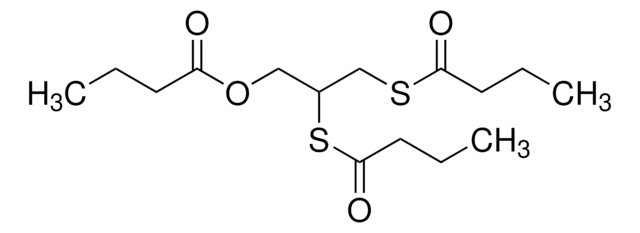D7881
meso-2,3-Dimercaptosuccinic acid
~98%
Synonyme(s) :
2,3-Dithio-meso-tartaric acid, DIM-SA, DMS, DMSA, Succimer
About This Item
Produits recommandés
Essai
~98%
Niveau de qualité
Forme
powder
Pf
196-198 °C (dec.) (lit.)
Température de stockage
−20°C
Chaîne SMILES
OC(=O)[C@@H](S)[C@@H](S)C(O)=O
InChI
1S/C4H6O4S2/c5-3(6)1(9)2(10)4(7)8/h1-2,9-10H,(H,5,6)(H,7,8)/t1-,2+
Clé InChI
ACTRVOBWPAIOHC-XIXRPRMCSA-N
Vous recherchez des produits similaires ? Visite Guide de comparaison des produits
Catégories apparentées
Application
It can be used:
- As a reducing and stabilizing agent to synthesize monolayer-protected gold clusters.[2]
- For terminal carboxylation of the oleylamine coated Fe3O4 nanoparticles, to develop targeted curcumin drug delivery system.[3]
Code de la classe de stockage
11 - Combustible Solids
Classe de danger pour l'eau (WGK)
WGK 2
Point d'éclair (°F)
Not applicable
Point d'éclair (°C)
Not applicable
Équipement de protection individuelle
Eyeshields, Gloves, type N95 (US)
Faites votre choix parmi les versions les plus récentes :
Certificats d'analyse (COA)
Vous ne trouvez pas la bonne version ?
Si vous avez besoin d'une version particulière, vous pouvez rechercher un certificat spécifique par le numéro de lot.
Déjà en possession de ce produit ?
Retrouvez la documentation relative aux produits que vous avez récemment achetés dans la Bibliothèque de documents.
Les clients ont également consulté
Active Filters
Notre équipe de scientifiques dispose d'une expérience dans tous les secteurs de la recherche, notamment en sciences de la vie, science des matériaux, synthèse chimique, chromatographie, analyse et dans de nombreux autres domaines..
Contacter notre Service technique










